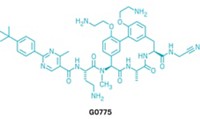Advertisement
Grab your lab coat. Let's get started
Welcome!
Welcome!
Create an account below to get 6 C&EN articles per month, receive newsletters and more - all free.
It seems this is your first time logging in online. Please enter the following information to continue.
As an ACS member you automatically get access to this site. All we need is few more details to create your reading experience.
Not you? Sign in with a different account.
Not you? Sign in with a different account.
ERROR 1
ERROR 1
ERROR 2
ERROR 2
ERROR 2
ERROR 2
ERROR 2
Password and Confirm password must match.
If you have an ACS member number, please enter it here so we can link this account to your membership. (optional)
ERROR 2
ACS values your privacy. By submitting your information, you are gaining access to C&EN and subscribing to our weekly newsletter. We use the information you provide to make your reading experience better, and we will never sell your data to third party members.
Drug Discovery
Speeding tuberculosis drug development
Using weakened bacteria, researchers have found new drug targets and new compounds to develop
by Megha Satyanarayana
June 21, 2019
| A version of this story appeared in
Volume 97, Issue 25
A new drug-discovery assay that uses weakened bacteria could speed the development of antibiotics to treat tuberculosis (TB).
TB is a global health concern that kills 1.6 million people per year, according to the World Health Organization. The antibiotics used to treat the disease often need to be taken for months and can be toxic. And the bacteria that cause the disease, Mycobacterium tuberculosis (Mtb), have developed resistance to many of the antibiotics in use.
“There have actually been a few cases reported of TB that are resistant to essentially everything that is out there,” says Deborah Hung, the Broad Institute of MIT and Harvard researcher behind the development of the assay. In terms of drug development, she says, “new TB drugs have actually been one of the biggest pharmaceutical gaps.”
To develop the assay, her team created dozens of strains of Mtb, each with a genetic modification that tamps down the levels of a different protein that is required for the bug to survive. Drug candidates can more easily kill these weakened bacteria because they can block the activity of target proteins more effectively—making it easier for researchers to spot promising compounds with the assay (Nature 2019, DOI: 10.1038/s41586-019-1315-z).
In this way, the researchers tested 50,000 compounds on 152 unique strains of Mtb, discovering several classes of drugs that act on many different proteins. One interaction that stood out was between a compound called BRD-8000 and EfpA, an efflux pump. Hung says her team modified the base compound to create a methylpyrazole derivative called BRD-8000.3. This compound was able to kill normal strains of Mtb and is one of several the researchers are looking to further develop.
Peter Tonge, who studies the drug development process at Stony Brook University, says the assay is a “really innovative and interesting approach.” He says its strength is that it points to compounds that are starting blocks for drug development and targets that would have never been uncovered in traditional screens.
Laura Kiessling, a chemical biologist who studies the MtB cell wall at the Massachusetts Institute of Technology, says the study demonstrates a promising “interplay of genomic thinking and chemical biology thinking.”
She says this assay could be used for other infectious diseases and when drugmakers are looking to find antibiotics that work only on the infectious microbe, leaving the rest of a person’s microbiome intact.
“You could get a wealth of beautiful molecular information using this strategy,” Kiessling says.




Join the conversation
Contact the reporter
Submit a Letter to the Editor for publication
Engage with us on Twitter